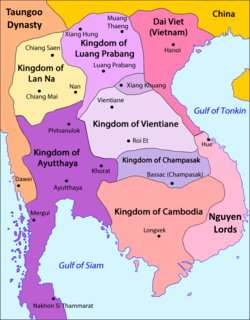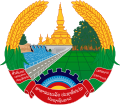Kingdom of Luang Phrabang
show This article may be expanded with text translated from the corresponding article in Russian. (September 2019) Click [show] for important translation instructions. |
show This article may be expanded with text translated from the corresponding article in Vietnamese. (September 2019) Click [show] for important translation instructions. |
Kingdom of Luang Phrabang ພຣະຣາຊອານາຈັກຫລວງພະບາງ | |||||||||
|---|---|---|---|---|---|---|---|---|---|
| 1707–1893 | |||||||||
 Flag | |||||||||
 The Kingdom of Luang Phrabang and its neighbors in 1750 | |||||||||
| Status | Vassal of Siam | ||||||||
| Capital | Luang Phrabang | ||||||||
| Common languages | Lao | ||||||||
| Religion | Buddhism | ||||||||
| Government | Absolute monarchy | ||||||||
| History | |||||||||
• Lan Xang divided | 1707 | ||||||||
• Haw wars | 1865–1890 | ||||||||
| 1893 | |||||||||
| 1893 | |||||||||
| |||||||||
| Today part of | Laos Thailand Vietnam China | ||||||||
| History of Laos | ||||||||||||
|---|---|---|---|---|---|---|---|---|---|---|---|---|
| Muang city-stats Era | ||||||||||||
|
||||||||||||
| Lan Xang Era | ||||||||||||
|
||||||||||||
| Regional Kingdoms Era | ||||||||||||
|
||||||||||||
| Colonial Era | ||||||||||||
|
||||||||||||
| Modern Era | ||||||||||||
|
||||||||||||
| See also | ||||||||||||
The Kingdom of Luang Phrabang was formed in 1707 as a result of the split of the Kingdom of Lan Xang. When The kingdom split, Muang Phuan became a tributary state of Luang Prabang. Then as the years passed, the monarchy weakened even more, that it was forced to become a vassal various times to the Burmese and the Siamese monarchies.
A French consulate was established in the capital of Luang Prabang in 1885. The kingdom was at this time a Siamese vassal, who feared French plans of annexing of Luang Phrabang. A treaty was signed on 7 May 1886 between Siam and France recognizing Siamese suzerainty over Luang Phrabang and neighboring Lao kingdoms.[1] France conducted expeditions in the region, searching for the possibility of establishing French territory there. A particularly destructive attack during the Haw wars by the Chinese Black Flag Army in 1887 saw King Oun Kham request French protection. This was accepted and signed on 27 March 1889, against Siamese protest.[2]
France and Siam went to war in 1893, culminating in the Paknam incident when France, contrary to promises it had made to Great Britain, entered Bangkok with warships. Siam was forced to accept the French ultimatum, to cede the lands east of the Mekong including its islands. The French Protectorate of Laos was officially established, with the administrative capital moved from Luang Prabang to Vientiane. However, Luang Prabang remained the seat of the royal family, whose power was reduced to figureheads while the actual power was transferred over to French officials including the vice consulate and Resident-General.[3] In January 1896, France and the United Kingdom signed an accord recognizing the border between French Laos and British Burma.
Kings of Luang Phrabang[]
- Kitsarat (1707–1713)
- Ong Kham (1713–1723)
- Thao Ang (Inthason) (1723–1749)
- (1749)
- Inthaphom (1749)
- Sotika-Kuomane (1749–1768) (Burmese vassal, 1765–1768)[4]
- Surinyavong II (1768–1788) (Burmese vassal, 1768–1788)[5]
- Siamese occupation (1791–1792)[5]
- Anurutha (3 February 1792 – 179..) (1st reign)
- Siamese occupation (179.. – 2 June 1794)
- Anurutha (2 June 1794 – 31 December 1819) (2nd reign)
- Manthaturath (31 December 1819 – 7 March 1837) (Regent for Anurutha from 1817 until 31 December 1819; lives as a monk in Bangkok from 1825 until 1826, leaving Luang Phra Bang to be administered by Thai officials)
- (1837–1838) (Regent)
- Sukha-Söm (1838 – 23 September 1850)
- Chantharath (23 September 1850 – 1 October 1868)
- Oun Kham (1 October 1868 – 15 December 1895) (Zakarine was regent for Oun Kham from April 1888 until 15 December 1895)
- Zakarine (15 December 1895 – 25 March 1904) (in the French protectorate)
- Sisavang Vong (26 March 1904 – 27 August 1946) (in the French protectorate)
From 12 October 1945 Sisavang Vong was officially King of Laos.
References[]
- ^ Carine Hahn, Le Laos, Karthala, 1999, pp. 60–64
- ^ Carine Hahn, Le Laos, Karthala, 1999, pp. 66–67
- ^ Carine Hahn, Le Laos, Karthala, 1999, pp. 67–68
- ^ Thant Myint-U (2006). The River of Lost Footsteps--Histories of Burma. Farrar, Straus and Giroux. pp. 98–99. ISBN 978-0-374-16342-6.
- ^ Jump up to: a b Tarling, Nicholas. The Cambridge history of South East Asia: From c. 1500 to c. 1800. 1. Cambridge University Press. p. 238. ISBN 978-0-521-66370-0. ISBN 0-521-66370-9.
- Kingdom of Luang Phrabang
- History of Laos
- History of Thailand
- Former countries in Southeast Asia
- Former kingdoms
- Former monarchies of Asia
- 18th century in Laos
- 19th century in Laos
- 20th century in Laos
- 18th century in Siam
- 19th century in Siam
- 20th century in Thailand
- States and territories established in 1707
- States and territories disestablished in 1949
- 1707 establishments in Asia
- 1949 disestablishments in Asia
- Former protectorates
- Former monarchies of Southeast Asia
- States and territories established in 1945
- States and territories disestablished in 1945
- 1945 establishments in Asia
- 1945 disestablishments in Asia
